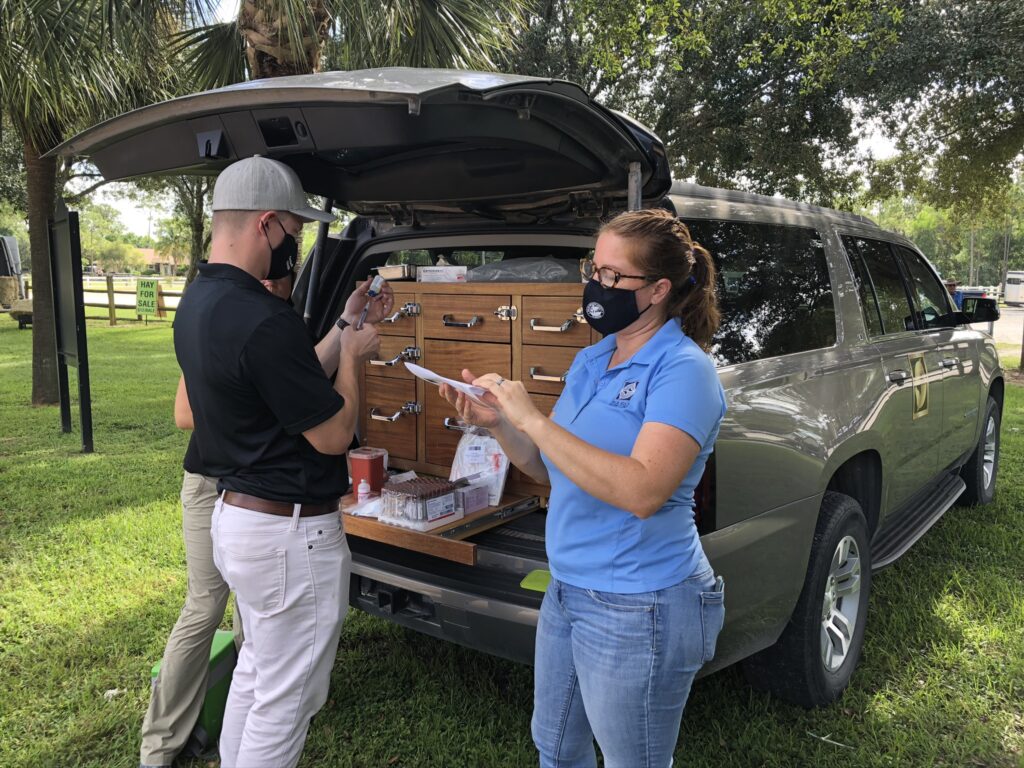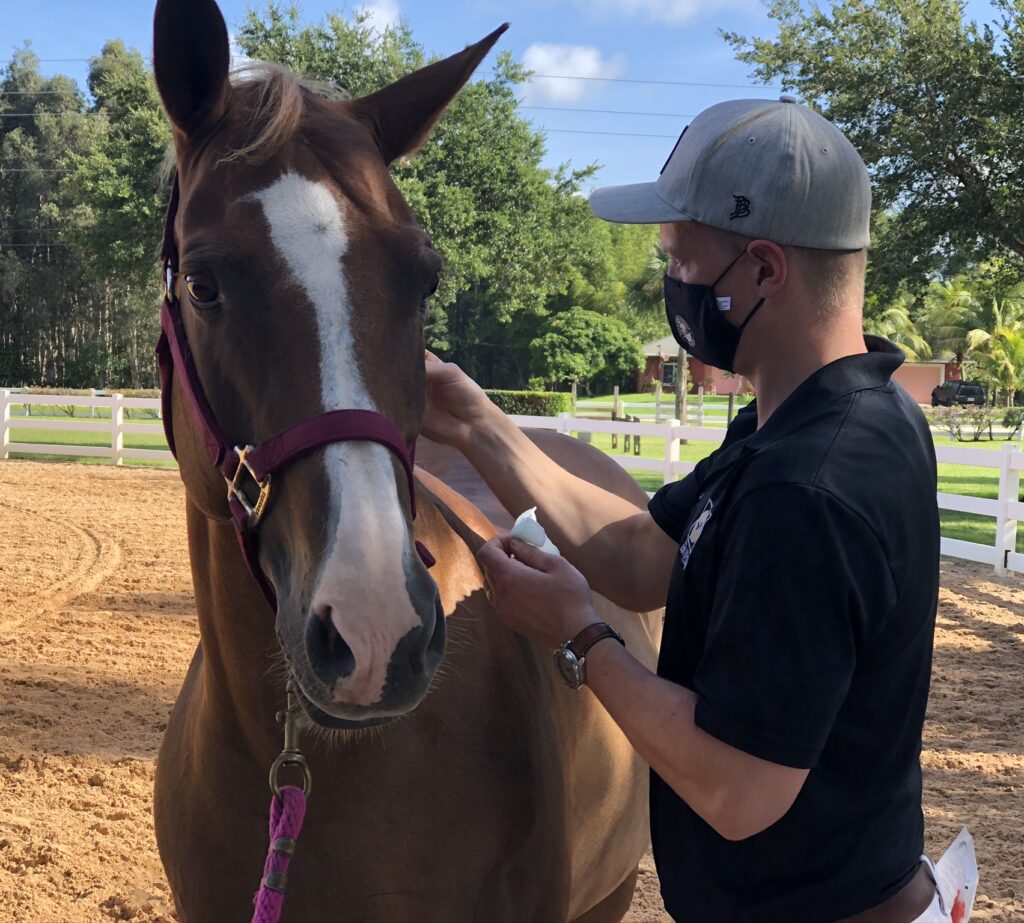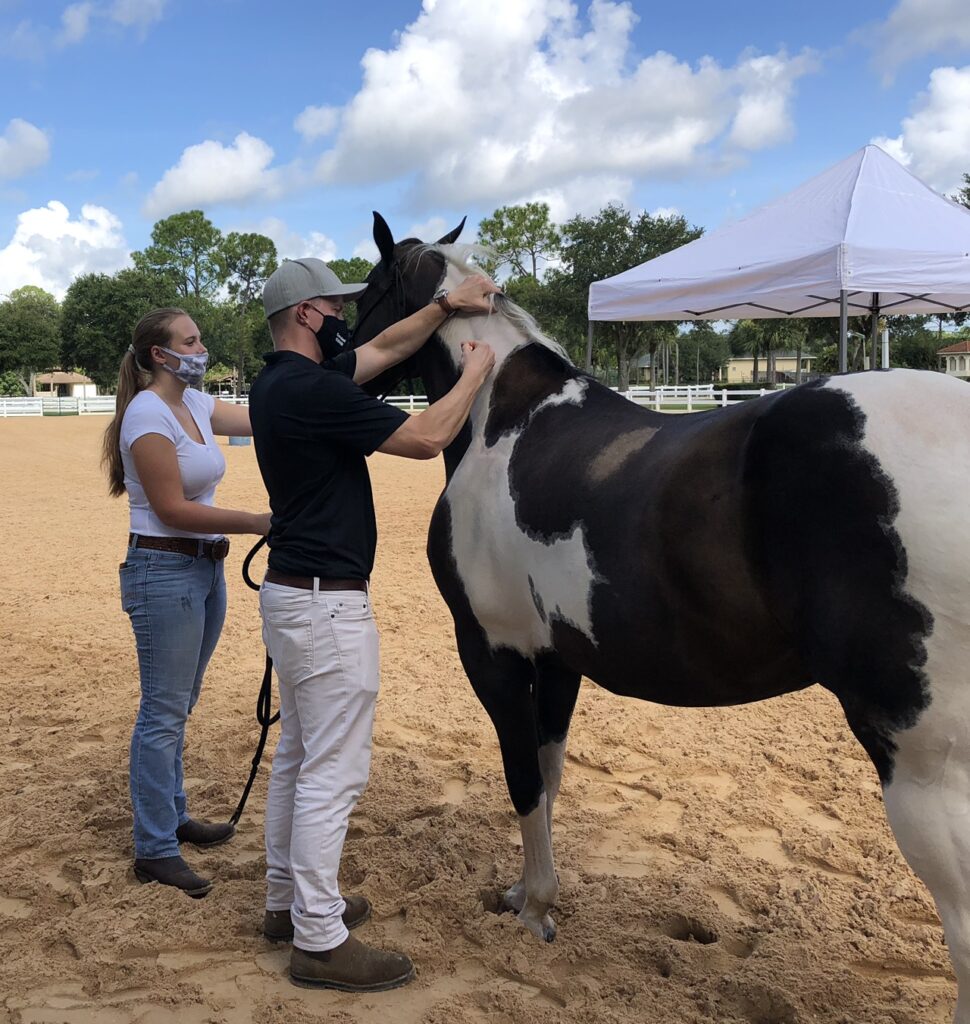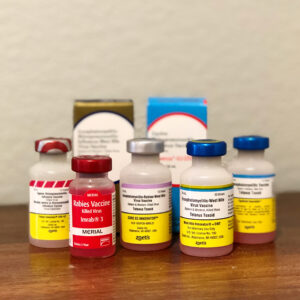Tag: horse health
As every horse owner knows, even in the most calculated situations, accidents can happen. As accomplished dressage professionals based at their Stoney Lake Equestrian in Stouffville, Ontario, Canada, and in Wellington, Florida, for the winter, Jaimey and Tina Irwin are well versed in horse care on the good days and the bad ones. Tina is a Canadian Pan American Games team gold and individual silver medalist, while Jaimey has also represented Canada at the FEI Dressage World Cup™ Final. Despite their decades of experience, they were still surprised when a training accident became a more serious issue.
One of the horses in the Irwins’ stables is Feininger, known as “Feine” in the barn. The Irwins purchased the Oldenburg gelding in Germany as a coming three-year-old in March 2021 with the hope of developing him into a future dressage star. However, during the 2023 winter season in Florida, he suffered a setback.
“Our assistant was lunging Feine when a palm frond fell and it spooked him, causing him to fall on the lunge line,” explained Tina. “He seemed okay after the fall initially, but later in the day he had some swelling on his hip. He had a temperature, and his respiration rate was quite high, so we had the vet out right away.”

Photo by KTB Creative Group
When the Irwins’ regular veterinarian arrived, they checked Feine’s blood levels and discovered the kidney values were elevated. At that point, it became apparent something more was going on than a typical lameness, and Feine was referred to Palm Beach Equine Clinic (PBEC), where Internal Medicine Specialist Dr. Fernando J. Marqués, DVM, Diplomate ACVIM, Diplomate ACVSMR, took over the case.
“I ran more specific blood work, a complete urinalysis, and I did a thorough ultrasonographic examination,” said Dr. Marqués of his diagnostic investigation. “When I performed the ultrasound, I saw that the horse had a hematoma on the pole of the kidney on the side that he fell. My other tests revealed that the horse was in acute renal failure, further supporting the finding on ultrasound. In sports medicine, we commonly talk about tendons, joints, and muscles, and sometimes we forget that horses have internal organs that can also fail. Just because you cannot see it doesn’t mean that everything is fine.”
Feine was admitted to PBEC for a few days so he could be properly treated for Acute Kidney Injury. Because the kidneys are such pivotal organs in maintaining the body’s balance, called homeostasis, the injury compromised Feine’s body’s ability to regulate the degree of acidity in the blood, electrolyte and water levels, and other substance concentrations.
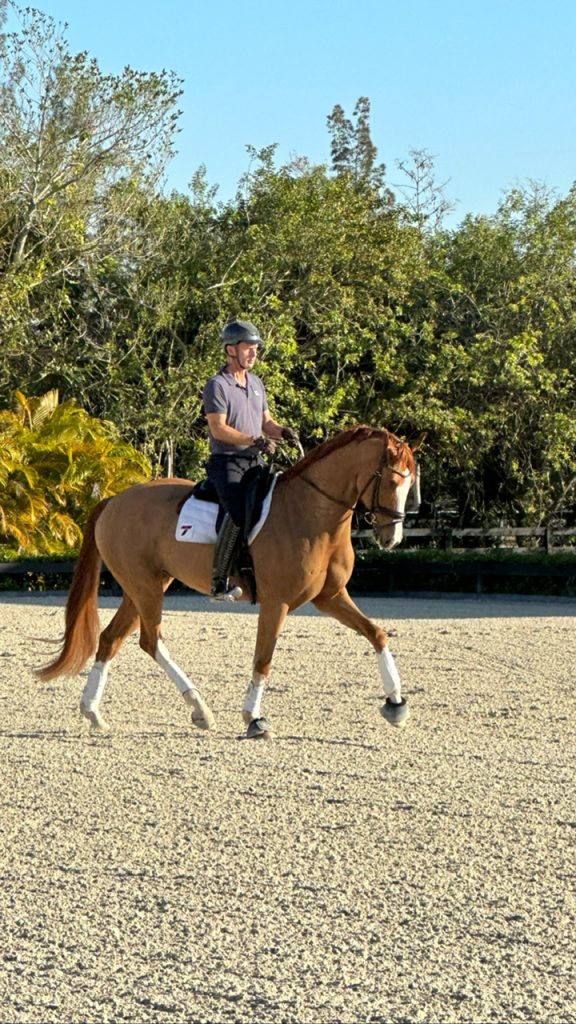
Photo by Courtesy of Team Irwin Dressage
“When the kidneys are under stress and are therefore failing to do their job properly, what you need to do as an internal medicine specialist is provide the body with what is needed to reestablish that optimum equilibrium,” shared Dr. Marqués. “By doing this, you help the body to balance all the things that cannot be balanced by the kidneys until the kidneys heal.”
While at PBEC, staff worked to give Feine’s body the support it needed. He was hooked up to a catheter and given continuous intravenous isotonic polyionic fluids. Under the direction of Dr. Marqués, Feine’s blood and urine were checked regularly to ensure the fluid solution given had the correct components and was administered at the optimal rate. Pain management can be an important part of injury treatment, but in this case, non-steroidal anti-inflammatory drugs (NSAIDs) could not be used because they can induce more damage to the kidneys.

Photo by KTB Creative Group
“There are many types of fluids you can give to a horse,” noted Dr. Marqués. “The compositions vary depending on what the horse needs in each specific case to reestablish a delicate and precise concentration of substances in the blood and other body compartments. For example, if you see from testing that there is one electrolyte that is pretty low, then you provide a fluid with more of that electrolyte.”
Having a horse in the clinic can be nerve-wracking for any horse owner, even if it’s just for a few days. With the right veterinary support and clear discourse, it becomes much easier to be involved in the recovery and achieve the best possible outcome.
“The communication with Dr. Marqués was exceptional,” commented Tina. “He would call and text us throughout the day and update us on Feine and his health. We went to visit him as well, and the entire experience was very positive.”
After a few days of treatment, Feine regained renal function and was able to return home. Though he was on the right track, it was still important to be sure his body continued to heal.
“Dr. Marqués continued to check in on Feine to see how he was doing after he was discharged from the Clinic,” recalled Jaimey. “He came to our farm in Wellington to check him personally.”
It was soon time for the Irwins to return to Canada. In the lead-up to the trip, Tina and Jaimey discussed with their regular veterinarian and Dr. Marqués the best plan to get Feine home safely. Everyone wanted to be as cautious as possible to prevent dehydration or any additional stress that travel could pose to Feine’s body, so all transportation options and logistics were considered. Fortunately, by the time the trip came, Feine had clinically returned to normal and he shipped smoothly, arriving safely up north.
“We kept in close communication throughout the entire process,” said Dr. Marqués of Feine’s treatment and recovery. “Good communication is so important between referring veterinarians, veterinarians in the clinic, and clients. This is a good example of if you were to wait too long, maybe it’s too late to solve the problem. The Irwins were really keen to do whatever was needed, so we were successful.”
Feine went on to compete throughout the 2023 summer season with Jaimey in the irons, notching several first-place finishes, including impressive scores of 75.172% and 78.846% in training level competition. He’s back on track toward the exciting dressage career he was meant to have.If you or your veterinarian would like to learn more about Palm Beach Equine Clinic’s and how it can help your horse, make an appointment at 561-793-1599 or learn more at www.EquineClinic.com.
What To Expect After the Unexpected Strikes
Featured on Horse Network
Every owner dreads having to decide whether or not to send their horse onto the surgical table for colic surgery. For a fully-informed decision, it is important that the horse’s owner or caretaker understands what to expect throughout the recovery process.
Palm Beach Equine Clinic (PBEC) veterinarian Weston Davis, DVM, DACVS, assisted by Sidney Chanutin, DVM, has an impressive success rate when it comes to colic surgeries, and the PBEC team is diligent about counseling patients’ owners on how to care for their horse post-colic surgery.

“After we determine that the patient is a strong surgical candidate, the first portion of the surgery is exploratory so we can accurately define the severity of the case,” explained Dr. Davis. “That moment is when we decide if the conditions are positive enough for us to proceed with surgery. It’s always my goal to not make a horse suffer through undue hardship if they have a poor prognosis.”
Once Dr. Davis gives the green light for surgical repair, the surgery is performed, and recovery begins immediately.
“The time period for the patient waking up in the recovery room to them standing should ideally be about 30 minutes,” continued Dr. Davis. “At PBEC, we do our best to contribute to this swift return by using a consistent anesthesia technique. Our team controls the anesthesia as lightly as we can and constantly monitors blood pressure. We administer antibiotic, anti-inflammatory, anti-endotoxic drugs, and plasma to help combat the toxins that the horse releases during colic. Our intention in the operating room is to make sure colic surgeries are completed successfully, but also in the most time-efficient manner.”
Colic surgery recovery often depends on the type and severity of the colic. At the most basic level, colic cases can be divided into two types – large intestine colic and small intestine colic – that influence the recovery procedures and outlook.
Large intestinal colic or impaction colic is characterized by the intestine folding upon itself with several changes of direction (flexures) and diameter changes. These flexures and diameter shifts can be sites for impactions, where a firm mass of feed or foreign material blocks the intestine. Impactions can be caused by coarse feeds, dehydration, or an accumulation of foreign materials such as sand.
Small intestinal colic or displacement colic can result from gas or fluid distension that results in the intestines being buoyant and subject to movement within the gut, an obstruction of the small intestine, or twisting of the gut. In general, small intestinal colics can be more difficult than large intestinal colics when it comes to recovery from surgery.
“Many people do assume that after the colic surgery is successfully completed their horse is in the clear,” said Dr. Chanutin. “However, during the first 24 to 48 hours after colic surgery, there are many factors that have to be closely monitored.
“We battle many serious endotoxic effects,” continued Dr. Chanutin. “When the colon isn’t functioning properly, microbial toxins are released inside the body. These microbials that would normally stay in the gastrointestinal tract then cause tissue damage to other bodily systems. We also need to be cognizant of the possibility of the patient developing laminitis, a disseminated intervascular coagulation (overactive clotting of the blood), or reflux, where a blockage causes fluids to back up into the stomach.”

Stages after surgery
Immediately Post-Surgery
While 30 minutes from recumbent to standing is the best-case scenario, Dr. Davis acknowledges that once that time period passes, the surgical team must intervene by encouraging the horse to get back on its feet.
Once a horse returns to its stall in the Equine Hospital at PBEC, careful monitoring begins, including physical health evaluations, bloodwork, and often, advanced imaging. According to Dr. Davis, physical exams will be conducted at least four times per day to evaluate the incision and check for any signs of fever, laminitis, lethargy, and to ensure good hydration status. An abdominal ultrasound may be done several times per day to check the health of the gut, and a tube may be passed into the stomach to check for reflux and accumulating fluid in the stomach.
“The horse must regularly be passing manure before they can be discharged,” said Dr. Chanutin. “We work toward the horse returning to a semi-normal diet before leaving PBEC. Once they are at that point, we can be fairly confident that they will not need additional monitoring or immediate attention from us.”
Returning Home
Drs. Davis and Chanutin often recommend the use of an elastic belly band to support the horse’s incision site during transport from the clinic and while recovering at home. Different types of belly bands offer varying levels of support. Some simply provide skin protection, while others are able to support the healing of the abdominal wall.
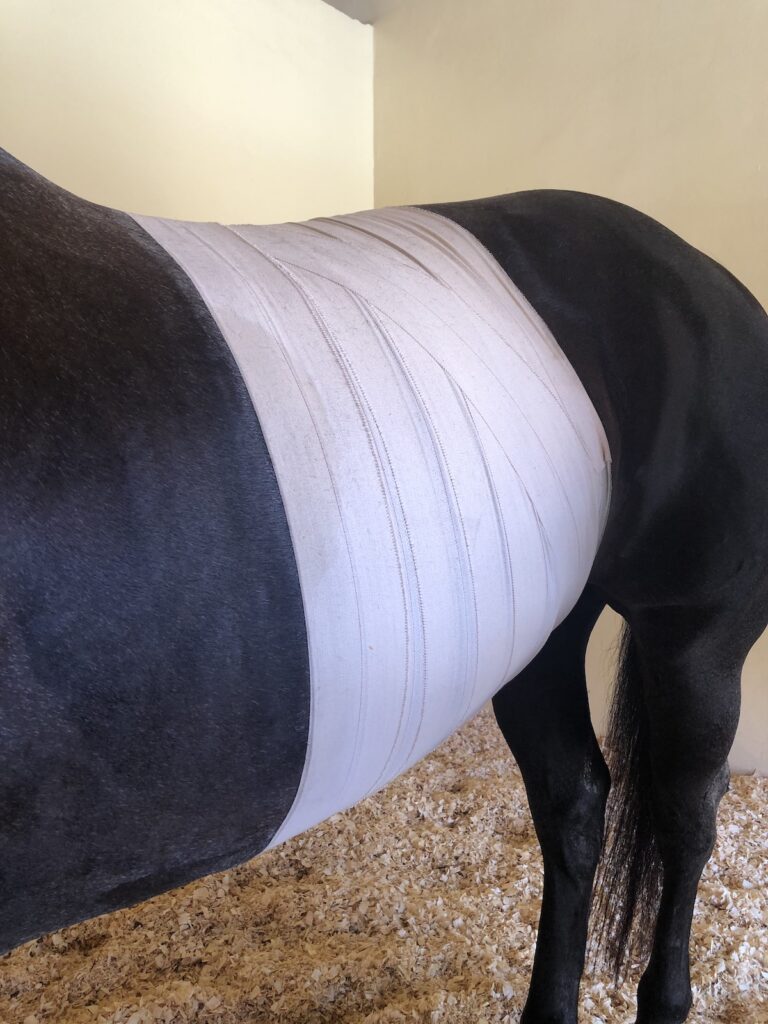
Two Weeks Post-Surgery
At the 12-to-14-day benchmark, the sutures will be removed from the horse’s incision site. The incision site is continuously checked for signs of swelling, small hernias, and infection.
At-Home Recovery
Once the horse is home, the priority is to continue monitoring the incision and return them to a normal diet if that has not already been accomplished.
The first two weeks of recovery after the horse has returned home is spent on stall rest with free-choice water and hand grazing. After this period, the horse can spend a month being turned out in a small paddock or kept in a turn-out stall. They can eventually return to full turnout during the third month. Hand-walking and grazing is permittable during all stages of the at-home recovery process. After the horse has been home for three months, the horse is likely to be approved for riding.
Generally, when a horse reaches the six-month mark in their recovery, the risk of adverse internal complications is very low, and the horse can return to full training under saddle.
When to Call the Vet?
Decreased water intake, abnormal manure output, fever, pain, or discomfort are all signals in a horse recovering from colic surgery when a veterinarian should be consulted immediately.
Long-Term Care
Dr. Davis notes that in a large number of colic surgery cases, patients that properly progress in the first two weeks after surgery will go on to make a full recovery and successfully return to their previous level of training and competition.
Depending on the specifics of the colic, however, some considerations need to be made for long-term care. For example, if the horse had sand colic, the owner would be counseled to avoid sand and offer the horse a selenium supplement to prevent a possible relapse. In large intestinal colic cases, dietary restrictions may be recommended as a prophylactic measure. Also, horses that crib can be predisposed to epiploic foramen entrapment, which is when the bowel becomes stuck in a defect in the abdomen. This could result in another colic incident, so cribbing prevention is key.
Generally, a horse that has fully recovered from colic surgery is no less healthy than it was before the colic episode. While no one wants their horse to go through colic surgery, owners can rest easy knowing that.
“A lot of people still have a negative association with colic surgery, in particular the horse’s ability to return to its intended use after surgery,” said Dr. Davis. “It’s a common old-school mentality that after a horse undergoes colic surgery, they are never going to be useful again. For us, that situation is very much the exception rather than the rule. Most, if not all, recovered colic surgery patients we treat are fortunate to return to jumping, racing, or their intended discipline.”
Understanding Anhidrosis in Horses
Check out the August 2021 issue of POLO Players Edition and flip to the Equine Athlete section to read about anhidrosis. Palm Beach Equine Clinic veterinarians describe what a diagnosis of non-sweating entails for the sport horse, signs/symptoms, and best management practices to keep anhidrotic horses comfortable. Read about anhidrosis in horses by clicking here or on the image below.
For future educational resources on horse health, subscribe to the United States Polo Association official magazine POLO Players Edition, and follow Palm Beach Equine Clinic on Facebook, Instagram @pbequineclinic, and Twitter @palmbeachequine.
10:30 a.m. on March 4, 2021 – Equine Herpesvirus (EHV) is a highly infectious DNA virus found all over the world. Currently, there is an outbreak of the neurological form of EHV-1 in Europe, which originated in Spain. This has resulted in outbreaks in at least three other European countries and the cancellation of FEI competitions through the month of March.
EHV-1 is contagious and spread by direct horse-to-horse contact via the respiratory tract through nasal secretions or indirectly through surfaces that have been contaminated with the virus.
In Wellington, Florida, we currently have no reported cases of affected horses. Our location in the Winter Equestrian Capital of the World poses its own risk factors with large numbers of horses in close quarters and under the stresses of competition and travel. This heightens our shared responsibility to take specific measures that will help keep each horse safe from the virus. We can work towards this by implementing two strategies: biosecurity and vaccination protocols.
1. Biosecurity
Implementing thorough hygiene and biosecurity protocols is important at all times, even when an outbreak has not occurred. Biosecurity and preventing the spread of disease is fresh in our minds due to the COVID-19 pandemic, and owners must now implement specific protocols at their barns for the safety of their horses. Some biosecurity steps to prevent the spread of EHV-1 include:
- Limit direct contact of your horse with others whenever possible – think equine “social distancing.” Do not use communal water buckets and avoid mixing of horses wherever possible.
- Take your horse’s temperature twice daily and report any horse with a temperature above 101.5 degrees Fahrenheit to your veterinarian immediately.
- Pay close attention for signs of respiratory or neurological disease. Clinical signs of neurologic disease may include incoordination, hind limb weakness, lethargy, head tilt, inability to get up after laying down, and inability to maintain balance. Clinical signs of respiratory disease often include discharge from the nostrils or eyes or swelling in the throatlatch area.
- Do not share buckets, halters, leads, bridles, or other tack between horses to prevent possible cross contamination. Clearly label your equipment, and if you must share, make sure to scrub and thoroughly clean equipment with detergent before using with another horse.
- Prevent people in your barn from potentially transferring the virus by washing your hands between handling different horses. Bring a change of clothes and shoes incase a horse is suspected of being infected.
- If you suspect your horse may be infected or has a high temperature, immediately isolate them from the other horses at your barn and contact your veterinarian. Ideally, a potentially sick horse should be moved into a separate building or paddock, or to an isolation facility. Palm Beach Equine Clinic is equipped with a USDA-approved quarantine center and is readily available to initiate the laboratory diagnostics required for diagnosing EHV-1.
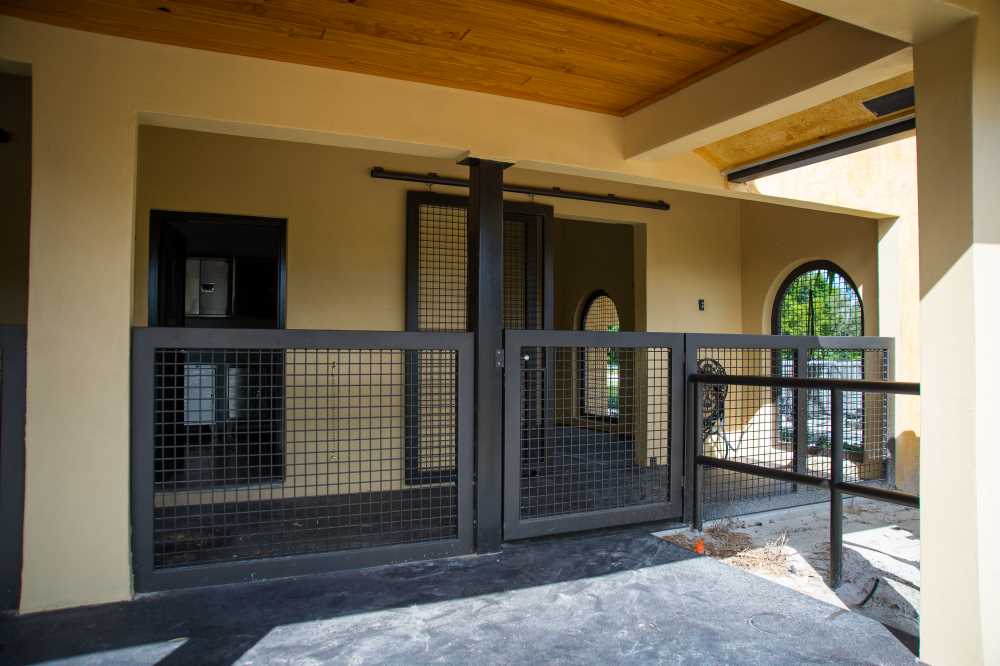
2. Vaccinate
Making sure your horse is up to date on all their vaccines will help strengthen their immune system against potential viruses. There are vaccines available to protect against the respiratory disease and abortion-causing EHV (Rhinopneumonitis vaccine), however, there is no vaccine available for protection against the neurologic form. Some EHV vaccines can reduce nasal shedding of the disease, therefore potentially reducing transmission. Please contact your veterinarian for any questions regarding vaccinating your horse.
What To Do Next
If you have recently imported a horse or are planning for the arrival of a horse from any country in mainland Europe, please take extra precaution by calling your veterinarian. In addition to implementing biosecurity measures in the barn, Palm Beach Equine Clinic veterinarians recommend that your imported horse receive a nasal swab and blood sample to detect the virus by PCR (polymerase chain reaction), which will identify the DNA of the virus.
EHV is a normally occurring virus in the equine population, but by following vaccination and biosecurity protocols, outbreaks can be minimized and contained. Early identification and reporting of the virus is key to tracing and preventing further spread. If you have any questions or concerns about your horse horse’s health, please contact Palm Beach Equine Clinic at 561-793-1599 to speak with a veterinarian.

Additional Resources:
Palm Beach Equine Clinic provided veterinary services for horse owners as part of a new clinic series by the Acreage Landowners’ Association, Western Equestrian Shows and Trails, and the Indian Trail Improvement District.
Loxahatchee, FL (August 18, 2020) – Kicking off a first-of-its-kind clinic series for horse owners of western Palm Beach County, several Acreage groups enlisted the veterinary team of Palm Beach Equine Clinic (PBEC) to provide hurricane preparedness expertise. The clinic, held on August 15, 2020, at Nicole Hornstein Equestrian Park in Loxahatchee, Florida, was originally scheduled for the first of the month, but was postponed in true Florida fashion due to Hurricane Isaias.
The Equine Hurricane Preparedness Clinic garnered a couple dozen attendees, masked up with their horses in tow. Kim Emmons, Western Equestrian Shows and Trails (WEST) Clinic Director and certified equine veterinary technician, is the driving force behind the event series.
“I’ve lived in and have been active in our local equestrian community for over 20 years,” said Emmons, who led the discussion on best practices for horse owners during hurricane season.
“The goal of this clinic series is to educate our local equestrian community and provide opportunities for horse owners of all ages and disciplines to become better, more well-rounded horsemen.”
Kim Emmons
Through attending equestrian events, teaching at camps, and her experience as a veterinary technician, Emmons has met many horse owners who lack the correct skills and knowledge on basic horse health and care. “I have always found it really rewarding to share my knowledge by teaching people the proper, practical skills for caring for their horses. Things such as correct leg bandaging, taking their horse’s vitals, listening to gut sounds, and teaching people on when they need to call a veterinarian are all essential for a horse owner to know. I used to teach an equine healthcare camp, and I am so proud to see those young campers grow into the smart, well-rounded equestrians they are today.”
The clinic series is free to attend, with fees for trailering in and offered membership packages, and will be based at Nicole Hornstein Equestrian Park for the foreseeable future.
PBEC provided special reduced rates on equine vaccinations, Coggins (Equine Infectious Anemia) testing, and microchipping services performed by Dr. Janet Greenfield-Davis and Dr. Charley McColough.
“We understand that, especially now in these pandemic times, many people are struggling to cover their horse’s expenses,” said PBEC veterinarian Dr. Greenfield-Davis. “We are happy to be here for the community by providing these essential services at more affordable prices and in a more convenient location for the Acreage horsemen.”
WEST, a new subcommittee of the Acreage Landowners’ Association (ALA), is led by fellow longtime Acreage resident Dixie Thiery.
“All of our efforts are focused on promoting and protecting the wonderful equestrian lifestyle we are lucky to enjoy here,” said Thiery. “We hope that WEST and this clinic series will help strengthen our community by giving people an easy, convenient way to learn and meet their neighboring equestrians. We are also very fortunate to be supported by the Indian Trail Improvement District, which is responsible for this park, and we are working with them to update our local trail system maps and better plan for equestrian-safe roadways and developments.”
ALA, WEST, ITID and PBEC plan to work together in the future by collaborating to bring horse shows, tack sales, exhibitions, and other educational events for equestrians to the area. The association’s next clinic is planned for September 19 and will focus on basic equine first aid.
Dr. Scott Swerdlin Discusses His Thoughts on Being Strategic About Your Horse’s Health During the COVID-19 Pandemic
As we all know, the United States Equestrian Federation has suspended all points and ratings for the immediate future as a result of the coronavirus (COVID-19) pandemic. This unfortunately resulted in the cancellation of the Winter Equestrian Festival, Adequan Global Dressage Festival, and major equestrian competitions around the world. However, this does not mean that all riding and training must come to a halt.
For the health and safety of ourselves and our loved ones, we must follow recommendations from the Center for Disease Control and Prevention to help reduce the spread of COVID-19. We are fortunate that Wellington, specifically the Equestrian Overlay Zoning District, is not a high-density area. Wellington offers picturesque bridle paths, idyllic weather and an abundance of expertise in all facets of the equine industry. Now is a unique opportunity for those who have been occupied by hectic schedules to take a step back, de-stress and even enjoy social distancing by saddling up and exploring the endless miles of excellent bridle paths.
Let’s make the most of our time in Wellington while awaiting the unclear future of the COVID-19 pandemic by continuing to ride and train our horses. Let’s try to keep a degree of normalcy in our daily routines and use this time wisely by improving both horse and rider health and well-being. Let’s use this time to ensure our horses remain in peak performance and ready to resume competition schedules when that time arrives.
Avenues for Enhancing and Maintaining Optimal Equine Health
It is vital for teams to have a veterinarian by their side keeping a close eye on the equine athlete’s health, performance and well-being. Closely monitoring a horse’s condition is key to catching potential injuries before they progress into issues that require more serious treatments. Here are some recommendations to consider incorporating during this break in competition that may benefit your horse when its time to step back into the show ring.
Preventive Medicine
Now is a perfect time to update your horse’s vaccinations and make sure your horse is ready to step back onto the showgrounds when competition resumes. Spring equine vaccinations to consider include:
- Encephalomyelitis, Eastern (EEE) and Western (WEE)
- Influenza
- Rhinopneumonitis (Herpesvirus)
- West Nile Virus
- Rabies
- Tetanus
- Strangles
For horses returning to areas where Potomac Horse Fever exists, a booster for that disease is highly recommended. Ensuring your Coggins test and records are up to date is always beneficial. For questions regarding equine vaccinations, please call Palm Beach Equine Clinic at 561-793-1599 to speak with a veterinarian.
Maintenance & Regenerative Medicine
Allowing our equine athletes to thrive while extending their performance careers may require Sport Horse Medicine to improve their comfort, well-being and performance. Many horses benefit from having their hocks, stifles, and/or coffin joints injected. Horses must be thoroughly evaluated by a sport horse veterinarian to determine the necessity and potential benefit of maintenance medicine before any corticosteroid injection is administered.
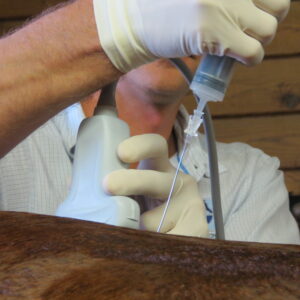
To further address the wear and tear incurred from intense training and competition, Regenerative Medicine is a non-steroidal option for activating and enhancing the horse’s innate bodily healing process. Palm Beach Equine Clinic offers advanced regenerative therapies for treating musculoskeletal injuries, osteoarthritis or degenerative joint disease.
- Platelet Rich Plasma (PRP)
- Interleukin-1 Receptor Antagonist Protein (IRAP)
- Autologous Conditioned Serum
- Pro-Stride Autologous Protein Solution
Alternative Therapies

Employing a holistic approach to treating patients, Palm Beach Equine Clinic offers veterinarians with a wealth of expertise in Alternative Medicine. Alternative therapies are often used in conjunction with traditional medicine and can be uniquely tailored to enhance a horse’s performance and overall health.
- Equine acupuncture and electroacupuncture
- Veterinary chiropractic manipulations
- Laser therapy (from low-level to regenerative laser options)
- Shockwave therapy
- Chinese Herbal Medicine
Reproduction & Fertility
Now may be the perfect time to plan for a future competition partner by breeding your horse. Palm Beach Equine Clinic is proud to offer highly successful Embryo Transfer program. Utilize this time to begin the breeding process by having your mare safely bred through artificial insemination, with the embryo collected 7-8 days after pregnancy. A detailed Breeding Soundness and Fertility Evaluation can jumpstart your future show ring champion. Palm Beach Equine Clinic provides veterinarians with expertise in Advanced Reproductive Services and Fertility Solutions, including:
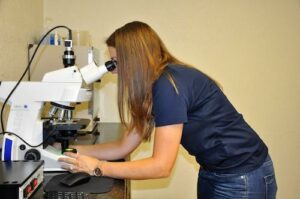
- Stallion or Mare Breeding Soundness and Fertility
- Embryo transfer: an ideal option for mares with busy competition schedules
- Genetic cloning (geldings, mares or stallions)
- Artificial insemination and semen collection, freezing, storage and shipping
Palm Beach Equine Clinic remains open and fully equipped with a team of 40 veterinarians, 60 technicians, fully stocked pharmacy, all-inclusive equine hospital and surgical suites. Speak with a PBEC veterinarian about your horse’s health and performance by calling 561-793-1599.

Dr. Marilyn Connor of Palm Beach Equine Clinic Discusses Balancing Your Horse’s Energy Sources for Performance
The modern equine athlete is asked to train and compete at far more demanding levels than horses in nature. Providing your horse with a diet that matches their metabolic needs, activity level, and training demands is key to success. To fuel our sport horses, we must first understand their nutrition and energy needs and give them the adequate support to succeed.
Physical Demands
Anaerobic vs. Aerobic Exercise

Glucose is stored in the liver and muscle cells as Glycogen, or a complex carbohydrate. Glycogen is broken down into glucose to meet metabolic energy requirements and provides energy for short to medium duration physical activity. Additionally, fat can be broken down and converted into glucose through a longer and more complex process.
Exercise can be characterized into two general categories: anaerobic and aerobic. Anaerobic exercise is characterized by short bursts of maximal effort activity, while aerobic exercise includes low to moderate intensity activity that lasts for a longer duration.
Both anaerobic and aerobic exercise utilize glucose as the primary source of fuel. Anaerobic and aerobic exercise differ in their secondary source of energy utilized once circulating glucose is depleted. Anaerobic exercise utilizes glycogen stores after glucose is depleted, while aerobic exercise is fueled by fat sources.
No equestrian sport is entirely anaerobic or aerobic. Most disciplines will have periods that require anaerobic and aerobic energy metabolism. Racehorses and western performance horses work at high intensity, fast speeds for short periods of time, requiring the body to utilize anerobic metabolism to produce energy. Show jumping and polo horses primarily use aerobic exercise yet will switch to anaerobic metabolism to keep up with energy demands of their sport. Eventing and endurance racing horses rely primarily on aerobic metabolism to support their energy needs over long periods of activity.
To support your horse during any type of sport, they must have a balanced nutrition program that sets them up for success.
Forage First

“Providing high quality forage is always my top focus for any nutrition program, regardless of the horse’s breed, age, gender, metabolic needs or athletic activity,” says Dr. Connor.
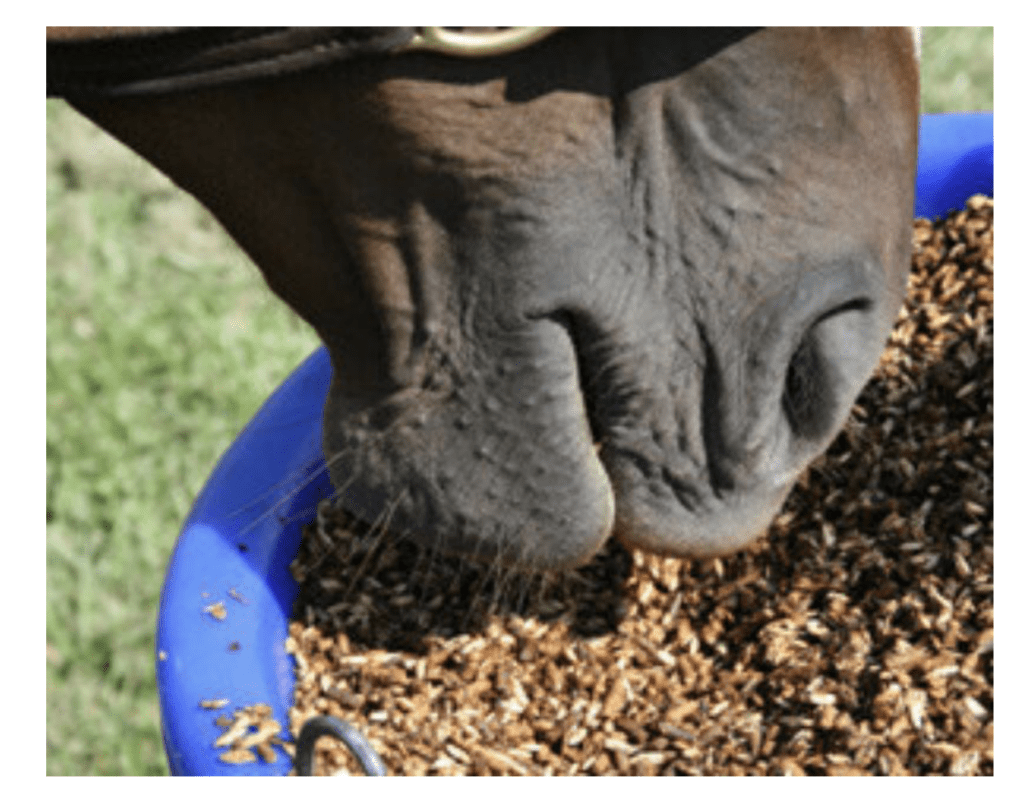
Horses are herbivores and evolved to survive by grazing on a steady supply of fresh grasses and plants. Research conducted on horses in nature shows that the average wild horse will spend 15 to 17 hours per day grazing and will travel 20 to 30 miles per day in their search for adequate food and water sources. To accommodate for the lifestyle of the modern sport horse, owners must provide high quality forage sources.
Fresh grass contains an optimal blend of key nutrients including protein, carbohydrates, vitamins and fatty acids. Once grass is cut, dried and baled as hay, the nutritional benefits begin decreasing. A week after cutting, hay loses about 60% of its vitamin A, E, and Omega 3 fatty acid content. As a general rule, horses should consume 1 to 1.5% of their body weight in hay or forage per day, with some high performing equine athletes requiring 2 to 2.5% to meet their energy needs.
When hay and forage alone are not enough to support the intense metabolic needs of the equine athlete, grain, and concentrated feed become an important part of the nutritional plan.
Building Blocks of Energy Sources
Feeding your horse with the appropriate mixture of carbohydrates, proteins, and fat is essential for fueling athletic performance.
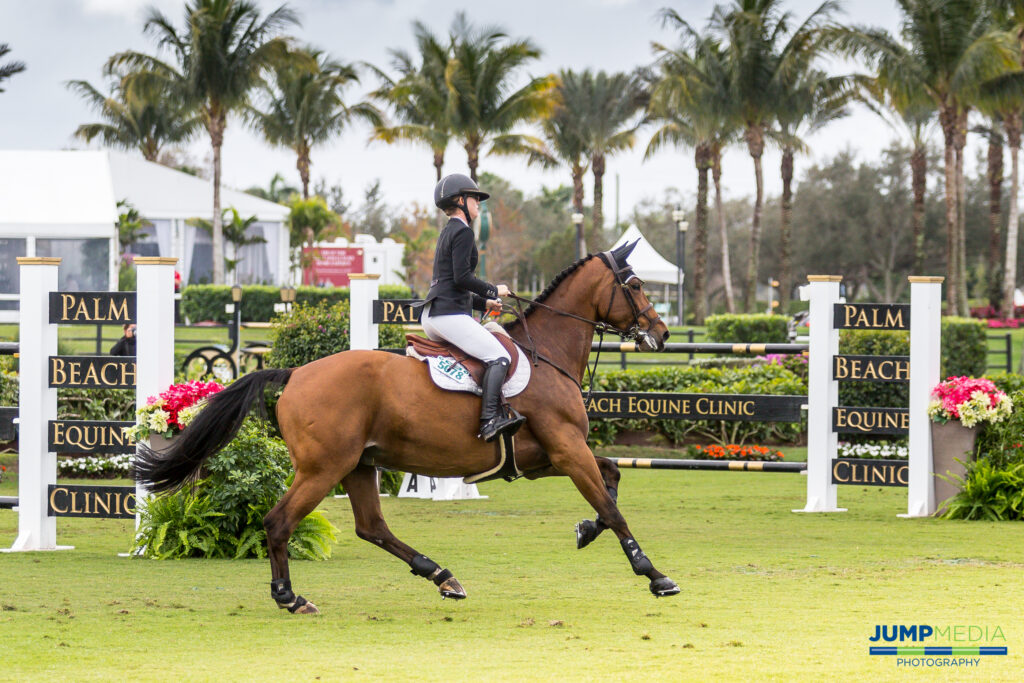

A horse whose training requires a high level of aerobic exercise, such as a dressage horse, should receive an adequate amount of fat and carbohydrates in their diet to fuel them through longer duration training sessions by providing extended, long-lasting energy sources. Racing and barrel horses, utilizing anaerobic exercise, require a higher percentage of carbohydrates in their diets to support them through maximal effort exercise for shorter periods of time.
Carbohydrates are sourced from forage, grains, and concentrated feeds. Forage sources provide a complex source of fibrous carbohydrates that require more time for the body to digest. Concentrated feeds and grains contain starchy carbohydrates that are easily digested and quickly converted into energy to fuel a horse through intense training. A well-balanced concentrated feed will also have an appropriate blend of fat, protein, and trace minerals.
Protein is an important part of the equine diet and is found in fresh grass, dried forage, and concentrated feeds in varying amounts. Protein is made of amino acids, which are the building blocks for growth, development, repair, and maintenance of body tissues. The modern equine athlete requires a substantial amount of dietary protein to support muscle growth and ongoing tissue repair.
Fat is a key component in most equine concentrated feeds and may be supplemented by adding flax seeds, flax oil, rice bran, and corn oil. These fat sources will provide slow burning calories for sustained energy release. Fat can be especially useful for supplementing a horse’s diet when they are a “hard keeper” or if they have an underlying metabolic condition that requires dietary carbohydrates to be limited.
It is important to remember that not all fats are created equal; as some fat sources can decrease or increase inflammation in the body. Flax seed and flax seed oil are rich in anti-inflammatory omega 3 fatty acids and can be an excellent source of energy. Corn oil is commonly used to add calories and fat; however, it is a less desirable supplement due to its higher percentage of omega 6 fatty acids, which contribute to inflammation. Concentrated feeds will have varying levels of added fats depending on the type of horse it is designed to feed.
Balancing Your Horse’s Energy Sources for Performance
Whatever equestrian discipline is your passion, your horse will need to be fueled by a balanced nutritional plan.
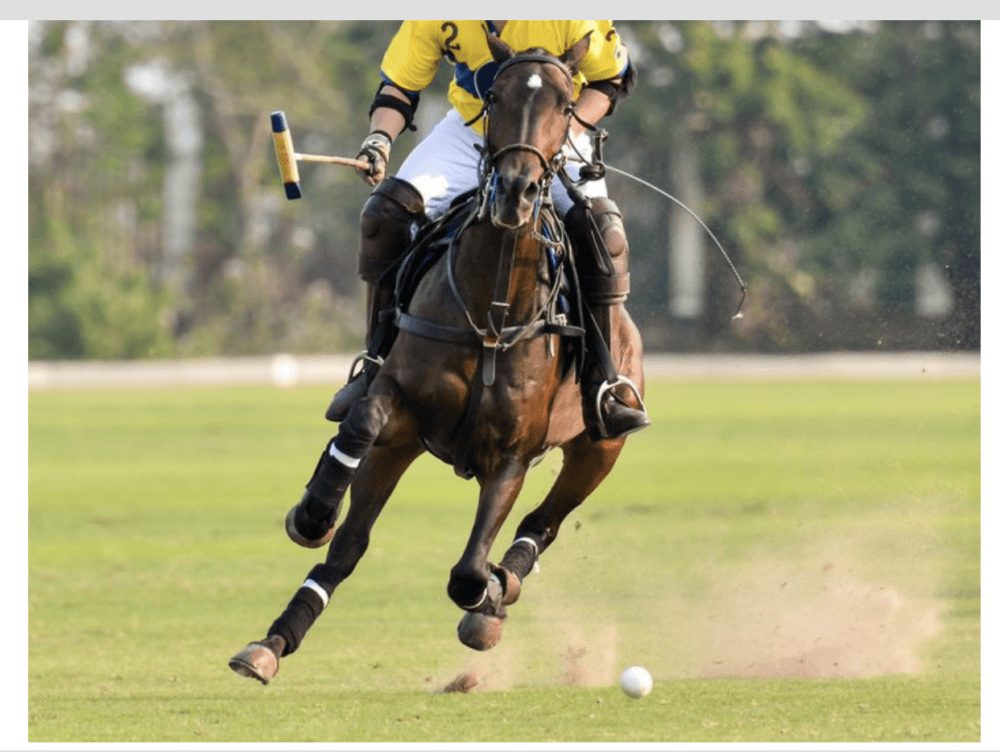
“Feeding instructions provided on grains and concentrated feed products are designed by nutritional companies as guidelines; they are not rules and should be adjusted based on total sources of nutrition,” said Dr. Connor.
Establishing the proper balance of forage, starchy carbohydrates, fat sources, vitamins, and minerals will be different for each unique horse and the demands placed upon them.
Understanding the nutritional demands of your horse can be very simple or very intricate, depending on your unique equine athlete. When designing a feeding program, it is important take into consideration your horse’s athletic discipline, performance level, metabolic needs, stage of life, and any underlying medical conditions. Furthermore, your horse’s nutritional needs will vary over time and as they age, so it is important to periodically assess your horse’s body condition and consult with a knowledgeable veterinarian.
Speak with Dr. Marilyn Connor of Palm Beach Equine Clinic about your horse’s unique nutritional needs to ensure your horse is fully supported and on track to reach your competitive goals.
Schedule a Nutritional Consultation with Dr. Connor
Fill out the form below or call 561-793-1599 to get started.
Horse Health Reminder: Hydration
Even in the winter months, it is important not to underestimate the heat, humidity, and sun. Palm Beach Equine Clinic stresses the importance of proper hydration and sun protection year-round, especially to Florida-based equestrians and winter season snowbirds.
There are many problems that can arise when temperatures climb, including overheating, dehydration, and colic. When the weather becomes chilly in Florida, horses often quit drinking as much water. This can lead to additional problems such as impaction. Your horse’s hydration is critically important for health and performance
Remember these 5 easy ways to protect your horse from sun and dehydration:
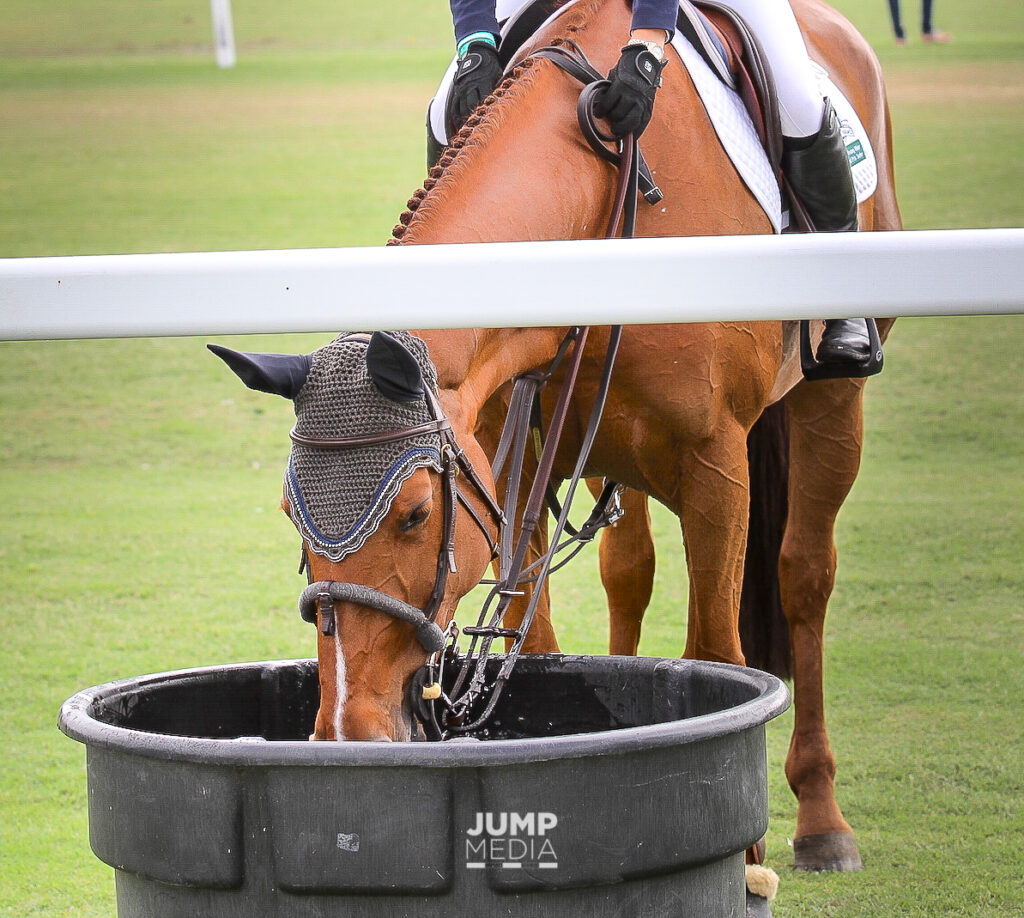
1. During extended periods of turnout, and when competing, horses should always have access to shaded areas. Scheduled rides and extended turnout should take place when the temperatures are lower, usually early mornings or in the evening on hot days, so the horse is not in direct sunlight.
2. The average horse drinks between five and 10 gallons of water per day. Therefore, easy and frequent access to clean, fresh water is a necessity. Pay special attention to increased intake during particularly hot days and plan accordingly.
3. Sodium in a horse’s diet is crucial for maintaining proper hydration. Providing a salt block or supplementing with properly measured electrolytes in a horse’s feed or water can help ensure that sodium requirements are being met and that your horse is drinking a sufficient amount of water.

4. Especially in the extreme summer heat, horse owners should pay attention to the amount of sweat their horse is producing. Anhidrosis, or the inability to sweat normally, can be a common challenge, particularly in hot, humid climates. In addition to lack of sweat, signs of anhidrosis can include increased respiratory rate, elevated temperature, areas of hair loss, or dry and flaky skin. If you notice any of these signs, contact Palm Beach Equine Clinic immediately.
5. Clean water buckets often and always fill with fresh water before leaving the barn. Veterinarians often recommend placing one bucket of fresh water and one bucket of electrolytes. Usually, a horse will balance his electrolytes with the opportunity to drink from one or more of these buckets.
These are just a few of the important issues to be aware of during the temperature change in Florida. Contact Palm Beach Equine Clinic to learn more about precautions that can be taken to keep horses happy and healthy throughout the winter competition season.
Thrush, rainrot, and scratches are problems that most equestrians have probably encountered, but in the hot, often humid summer months, these issues can incessantly plague horses and their owners. While different in their presentation, thrush, rainrot, and scratches have a lot in common. For horse owners, there are several problems that arise due to environmental factors or predisposing conditions, but these issues can easily be prevented or treated with proper care and management.
This month, Palm Beach Equine Clinic’s Dr. Bryan Dubynsky shared his expertise on the causes, treatment, and prevention of thrush, rainrot, and scratches.
Thrush
Thrush is an infection within the horse’s hoof most commonly caused by bacteria that invade the deep clefts or grooves (known as sulci) of the frog. Fusobacterium Necrophorum is the common bacterial culprit, which naturally occurs in the environment, especially in wet, muddy, or unsanitary areas. Thrush bacteria thrive where there is a lack of oxygen.
Some horses are predisposed to developing thrush due to conformation, such as a rather high heel or deep sulci, or a narrow or contracted heel. The bacteria will manifest in horse’s feet that are not picked out regularly, or standing in muddy, wet environments, including paddocks or stalls that have not been cleaned properly. Thrush can typically be first identified by the odor. The frog will have a strong, rotten odor and become spongy. Visually, the frog can even exudate (ooze) pus.
The treatment for thrush is fairly simple as it is very sensitive to oxygen. The most important thing is to have your vet or farrier trim or debride the frog to expose affected areas to the air. It is best to keep the hoof clean and dry. Adding a common detergent to the thrush areas, such as Betadine or any commercial product (Thrush Buster, Coppertox, etc.) will help to kill the bacteria. Most importantly, if the horse is not removed from those predisposing environmental factors, treatments can be ineffective.
Maintaining a level of activity for our equine partners will increase blood flow to the feet and promote health in the area. Horses found in dry environments with ample space to move typically do not suffer from thrush. The activity of horses moving keeps the frogs healthier. The more blood flow you have in the foot, the less chance there is for infection to manifest. Thrush does not always cause lameness. In extremely rare cases, thrush can penetrate deeper and cause an infection in deeper tissue or even in the coffin bone. When in doubt, always contact your veterinarian.
Rainrot (Dermotophilus Congolensis)
Rainrot is caused by a naturally occurring bacteria named Dermotophilus, which produces spores. The condition is recognized as scabby, scaly, crusty spots on areas of the horse that have been exposed to rain. It is commonly seen on the neck or across the back (dorsum). Rainrot is not typically apparent on the legs or under the belly. A surplus of rain on the skin washes away the natural protective oils. Once the skin is stripped of the natural protective layer or any sort of trauma to the skin barrier occurs, which can be even as simple as an insect bite, the Dermotophilus spores are able to invade the deeper dermis skin layers. The spores penetrate into the deeper layers of the dermis, and the body reacts by sending white blood cells and proteins to fight the invaders.
This reactive response causes small pustules, scabs, and bumps to form. Similar to thrush, rainrot is an environmental issue. It is most commonly seen in warm areas with high humidity, excess rain, and insects. The most important prevention is to keep horses out of prolonged periods of rain. A horse can be out in the rain for short periods of a day or two, but if it is constantly in hot and rainy conditions with biting insects, more than likely the horse will develop rainrot.
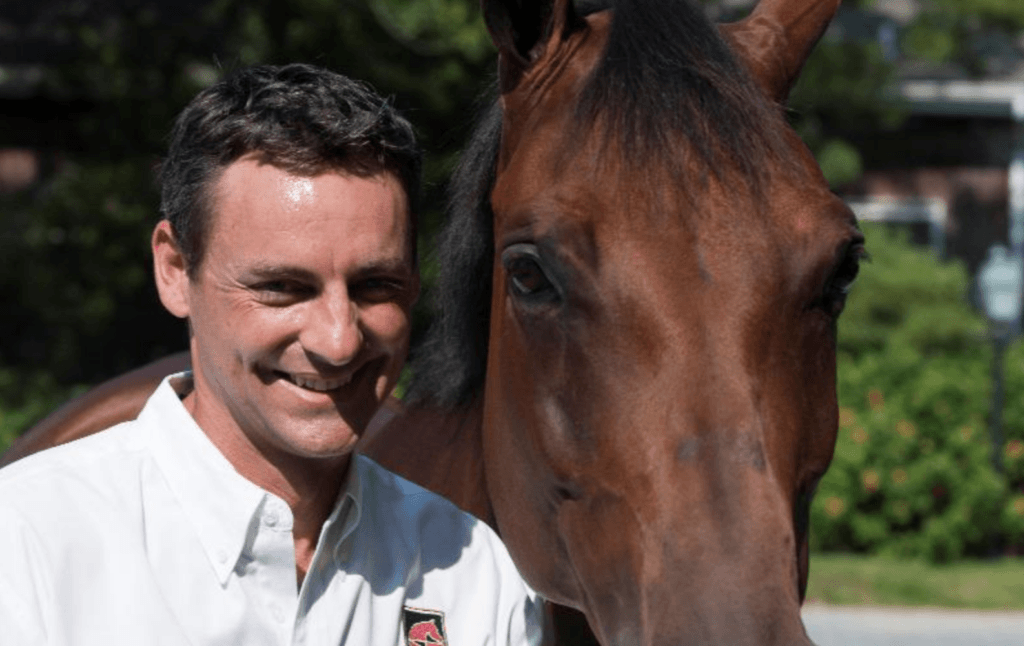
Dr. Dubynsky emphasizes that topical products are not worth anything if the horse is not removed from the environmental factors. Once you remove the environmental factors, a keratolytic agent (something that exfoliates keratin), such as benzoyl peroxide or an antibacterial shampoo, will help the skin heal. He also cautions that if the horse does have scabs, you do not necessarily want to pick the scabs off because then you are leaving open skin without protection for more bacteria to invade. The most important tip to healing is to keep the area dry.
In very rare, severe cases of rainrot, it is best to contact your veterinarian to put the horse on antibiotics. If left untreated, and the horse is not removed from the environmental causative factors, the infestation can lead to Staphylococcal Folliculitis; a type of Staph bacteria that will invade the hair follicles and cause a more serious situation.
Scratches
Scratches is a generic term for many different ailments. The definition of scratches can be a bacterial, fungal, or viral dermatitis or inflammatory condition of the pastern or fetlock. It is defined as a chronic Seborrheic Dermatitis, characterized by hypertrophy and exudation on the palmar plantar surface of the pastern and fetlock.
There are certainly predisposing factors for scratches, including the same environmental factors that cause thrush or rainrot. Predisposing factors for scratches include horses that are bathed often or stand in wet conditions all the time. Horses that have an excess amount of hair on their legs, especially draft horses, may be more prone to developing scratches. This is because the hair traps dirt and moisture on the skin. Scratches can develop in horses that are bathed too often, such as the intensely managed show horse. Frequent bathing of the horse can strip away the natural protective oils and barrier of the dermis. This allows bacteria or fungi to invade. When moisture penetrates the skin, it causes an inflammatory reaction. This presents as heat, redness, pain, and loss of protection to keep bacteria out.
The most effective first step for prevention and treatment should be to eliminate environmental predisposing factors. Removing excess hair during humid months and keeping horses clean and dry to the best of your ability will reduce the probability of developing an infection. Bathing horses once a day with Betadine or antifungal/antibacterial shampoo will help to clear the infection. Be sure to leave the shampoo on for 20 minutes for all of the medicine to penetrate. Rinse thoroughly, and make sure the horse is completely dry. In order to effectively treat the bacteria, horses, especially their legs, should be completely towel- or air-dried before being returned to their stalls or paddocks.
As always, contact your veterinarian immediately if there appears to be a deeper infection present, or if you would like more detailed information on how to treat and prevent these bacterial infections. To contact your Palm Beach Equine Clinic veterinarian, call 561-793-1599 or visit www.equineclinic.com.
When dressage rider Meagan Davis and owner Scott Durkin think about the goals they have for their dressage horse Royale, they have tunnel vision for the grand prix ring. Royale, a 16-year-old Oldenburg gelding (Routinier x Ironman) was well on his way to accomplishing that goal during the 2019 season when something strange started happening.
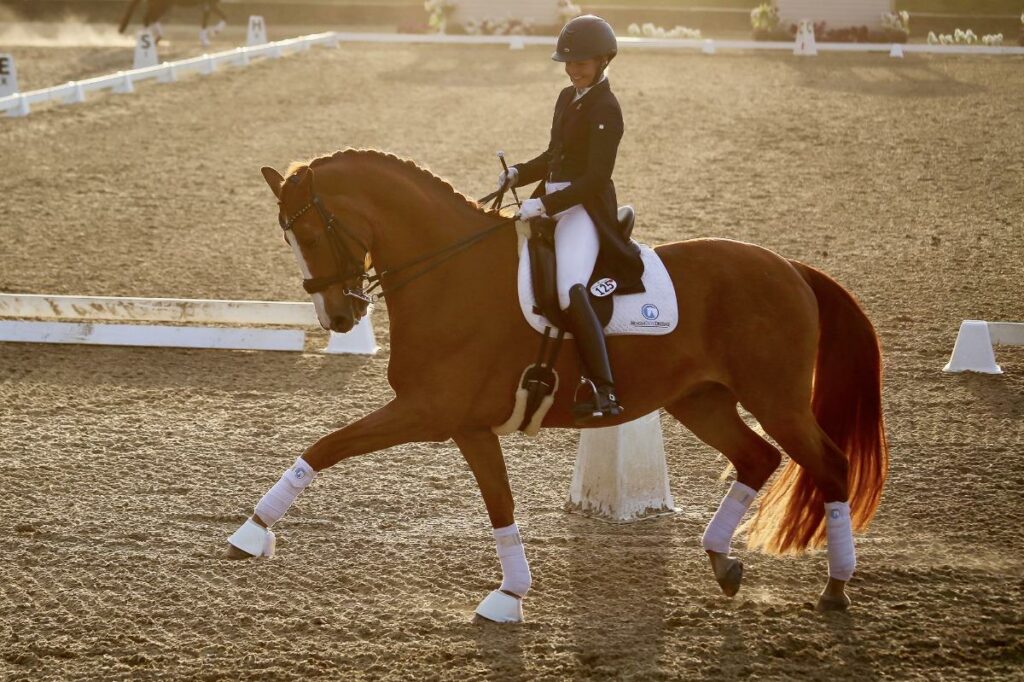
Photo courtesy of Meagan Davis
After arriving at their winter home in Loxahatchee, FL, from a northern base in Stone Ridge, NY, Davis kicked off Royale’s winter competition schedule with a show in January. The horse was coming off a very successful fall season that included CDI Intermediaire I and CDI Prix St. Georges victories at the New England Dressage Fall Festival and Dressage at Devon.
“Our first show was unusually chilly and I noticed that Royale was breathing a little hard and didn’t sweat very much,” recalled Davis. “I didn’t think that much of it because of the weather, but when we returned home and it warmed up, he wasn’t sweating at all.
“He could not catch his breath after being perfectly fit a month before,” continued Davis. “I rely on Palm Beach Equine Clinic for the care of all the horses in my barn and I immediately turned to Dr. Robert Brusie.”
Dr. Brusie is a Board-Certified Surgeon at Palm Beach Equine Clinic and was diligent about ruling out any physical causes of Royale’s obvious discomfort and decline in performance. After flexion tests, checking for musculoskeletal problems, and assessing soreness or wear and tear, Dr. Brusie turned to Palm Beach Equine Clinic’s Internal Medicine Specialist Dr. Peter Heidmann.
“Dr. Brusie was watching me work him one day, noticed the decline in muscle, the lack of sweating, and labored breathing, and recommended we take a deeper look with a specialist,” said Davis. “That is why I trust Palm Beach Equine Clinic with the care of my horses. They have so many tricks up their sleeves, and their clients are fortunate that the veterinarians collaborate so well together in order to do what’s best for the horse.”
Dr. Heidmann’s first step was to asses any neurological causes by testing for equine protozoal myeloencephalitis (EPM) and Lyme disease. Both were negative. He then moved on to a nutrient analysis.
“When you see weakness and poor muscle mass in a horse, two of the things you test for right away are vitamin E and selenium deficiencies,” said Dr. Heidmann. “Both are common causes of decreased performance due to low concentrations in local soil or the soil where a horse’s hay derives from.”
No deficiencies were found in Royale, which prompted Dr. Heidmann to move on to muscle testing. He drew blood from Royale, put him in work, and then drew blood again four to six hours later. When comparing enzymes in the blood from before and after work, Dr. Heidmann looked for any large increase, which would indicate the problem was in the muscles themselves. Royale’s tests, once again, came back normal.
At this point, Dr. Heidmann returned to the case history and started following the shortness of breath symptom, noting, “Breathing abnormalities in horses are difficult to diagnose by simply listening because their chest wall is so thick. What I wanted to asses was prolonged recovery. This is done by placing a bag over a horse’s nose to get them to breathe deeply. Once the bag is removed, breathing should regulate within two to three breaths. Royale needed four to five breaths.”
Once Dr. Heidmann identified a possible cause, he performed abronchoalveolar lavage (BAL), which is essentially a lung sample used to identify abnormal cells. He inserted a small-diameter tube through the trachea, flushed saline into the lung, and then suctioned it back out.
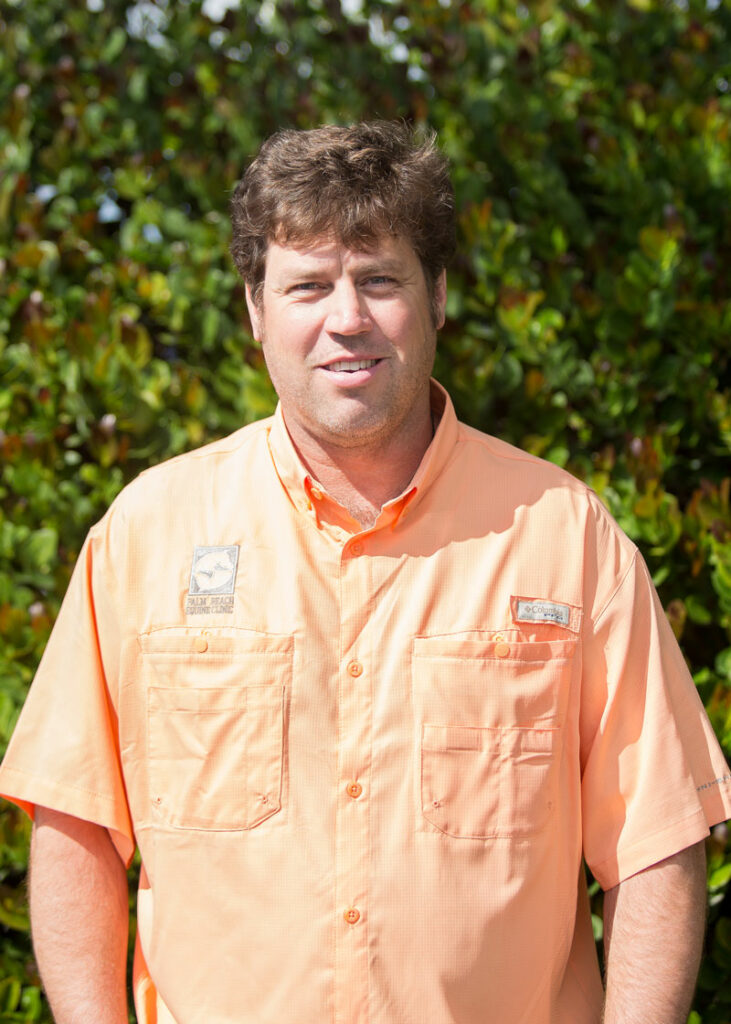
“Sure enough, when I examined the sample, there was mucus and abnormal cells,” said Dr. Heidmann. “Despite his bloodwork being normal and no obvious infections, Royale was battling equine asthma or ‘heaves.’”
The treatment for asthma in horses is very similar to what’s done for humans and includes an anti-inflammatory bronchodilator drug and inhaled steroids.
“While his breathing issues were significant enough to affect performance, Royale’s treatments were relatively mild with immediate and substantial improvement,” said Dr. Heidmann. “I used nebulized herbal remedies, steam, and Ventipulmin, which is an oral syrup.
“I’m a less-is-more person and veterinarian,” he continued. “I try to have the best outcome with the least amount of medications. Additionally, we created some routines that would minimize environmental dust and allergens, such as using a hay net, wetting down hay and bedding, or using chopped newspaper as bedding.”
Royale stayed on the prescribed medication through his trip home to New York and came off them at the end of May. Today, he is back in work and has regained the fitness and muscle he had during the fall. According to Davis, their goal is to step into the grand prix ranks during the upcoming season.
“My favorite cases are the sickest of the sick and the most elusive needle in a haystack,” concluded Dr. Heidmann. “Royale’s case definitely fell into the latter. It was really challenging, but rewarding because the outcome was a horse that is dramatically different than he was four months ago. But the most important part of this case for me was working together with Dr. Brusie. I would have not been successful in helping this horse if he hadn’t done all the work prior to coming to me. That kind of collaboration is what contributes to our success and sets Palm Beach Equine Clinic apart!”

